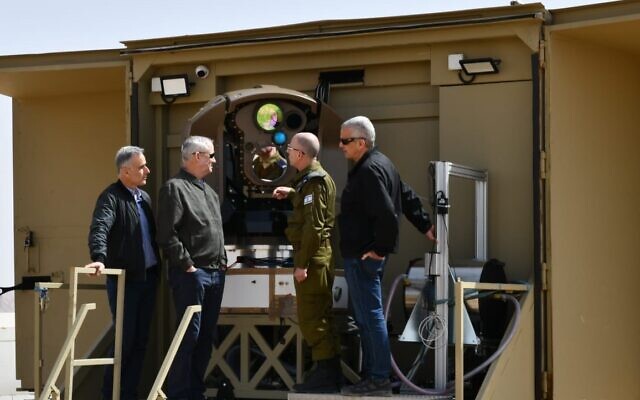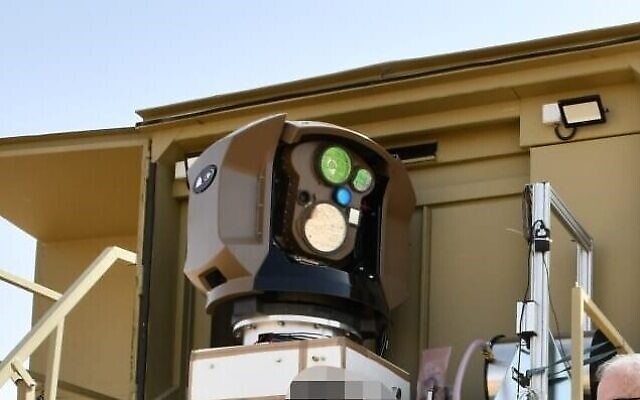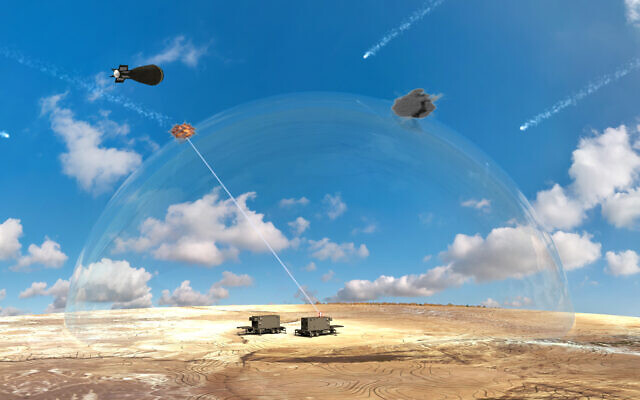Procurement starts for laser missile defense
System would be deployed in trial on Gaza border in several years, officials say

Defense Minister Benny Gantz said Thursday his office would be signing a contract in the coming days to begin procurement of a laser air defense system to protect Israel against rockets and UAVs.
“We are at the start of the journey. It will take time, it isn’t a short process, but we will get it done in the shortest amount of time possible,” Gantz told reporters.
His comments poured cold water on Prime Minister Naftali Bennett’s announcement last month that Israel would deploy the system within the year.
The ministry has been testing the laser-based defense system for several years, shooting down a drone with it last year. Its research and development department initially planned to deploy the anti-missile system by 2024, but the military has pushed for an earlier deployment.
This was apparently driven by concerns that in a future conflict, the military would not have sufficient interceptor missiles for the Iron Dome and other air defense systems to shoot down incoming rockets, missiles and drones.
According to the head of the ministry’s research and development team, Brig. Gen. (res.) Yaniv Rotem, the ground-based system will be ready within a “single-digit” number of years.
“We are completely ready to make the order… and begin full-scale development, which means finishing development and initial procurement,” Rotem said.

Gantz said hundreds of millions of shekels would be allocated to the final development stages and trial phase, in which the system will be placed on the border with the Gaza Strip, and hundreds of millions more shekels at the next stage, subject to progress in the trial.
The ground-based laser system — dubbed Iron Beam — which is being developed with the Rafael weapons manufacturer, is not meant to replace the Iron Dome or Israel’s other air defense systems, but to supplement and complement them, shooting down smaller projectiles and leaving larger ones for the more robust missile-based batteries, Rotem said.
Since development began, the high-power laser has proven more powerful than the ministry’s team initially aimed for, Rotem said, without detailing the exact number of kilowatts of electricity it operates on.
According to the Defense Ministry, so long as there is a constant source of energy for the laser, there is no risk of ever running out of ammunition.
The downside of a laser system is that it does not function well in times of low visibility, when there is heavy cloud cover and other inclement weather. For that reason, the ministry intends to also mount the system on an airplane, which would help get around this limitation by putting the system above the clouds, though that is still a few more years off, ministry officials have said.
“The powerful laser system is the first of its kind in the world,” said Rafael Advanced Defense Systems director-general Yoav Har-Even.
“After many years of research and development, we see this strategic plan as a significant milestone in upgrading Israel’s air defense capabilities,” he added.

“Today we are taking a dramatic and important step towards a change in the battlefield, and an upgrade in the security of Israeli residents amid the growing threats on our border from Gaza, Lebanon, and Syria, under the auspices of Iran and terror organisations,” Gantz said.
The Lebanese Hezbollah terror group is believed to maintain an arsenal of some 130,000 rockets, missiles and mortar shells, which the military believes would be used against Israel in a future war. The two largest terror groups in the Gaza Strip, Hamas and the Palestinian Islamic Jihad, are also each believed to possess thousands of rockets and mortar shells, even after firing upwards of 4,000 projectiles at Israel during last year’s 11-day war.
Israeli military officials have also said they have seen a growing trend in Iranian use of drone attacks in recent years, dubbing it Iran’s “UAV terror.”
Against these and other threats, Israel operates a multi-tiered air defense array, made up of the short-range Iron Dome, the medium-range David’s Sling and the long-range Arrow and Patriot systems.
Judah Ari Gross contributed to this report.
Times of Israel

comments